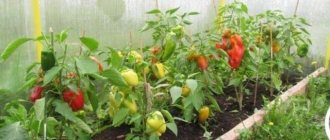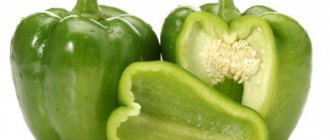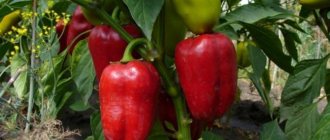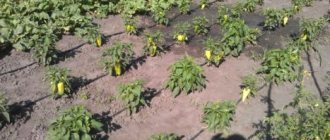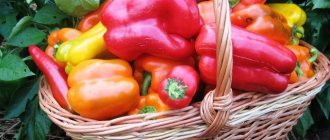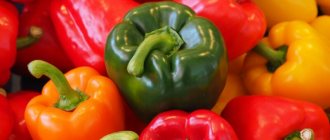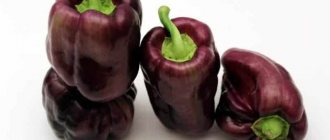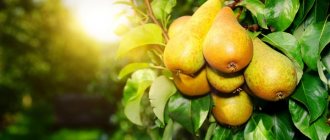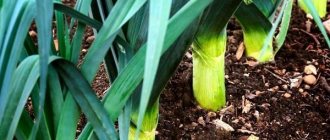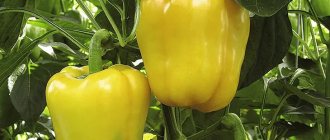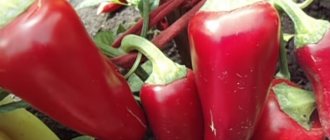This vegetable is an honored guest on any table. Green, yellow, purple and even orange fruits complement the taste of dishes. This handsome vegetable loves warmth and fertile soil. Growing your own garden requires certain knowledge and skills. A rich harvest depends not only on the correct organization of the planting process and care, but also on the correct choice of variety.
The works of breeders have given vegetable growers a wide variety of varieties. Detailed information about the best varieties of sweet peppers of 2019 (with photos and descriptions) is further in the article.
Sweet pepper varieties
Fragrant, juicy bell pepper fruits
Demand creates supply, and since sweet peppers are popular and in demand not only among gardeners, but also on a global scale, the seed market is replete with a variety of varieties of bell peppers, differing not only in taste characteristics, but also in terms of fruiting, and agricultural cultivation techniques.
Winnie the Pooh
This variety of pepper belongs to the early ripening category. The ripening period is shorter than that of other varieties - 100 days. The fruits are small, weighing 60 g. Thick-walled.
The pulp has a juicy texture and a sweetish taste. Use - mainly seaming. An undoubted advantage is resistance to diseases.
- Range of forest materials
How to choose the right compressor hose
Grape varieties - the best varieties, characteristics and cultivation characteristics (75 photos)
When deciding which bell pepper to choose, you need to take into account your own preferences and desires. Decide what you plan to do with this vegetable - eat it raw or can it - from this you need to dance, deciding on the variety. Also, be sure to plant several varieties of hot peppers.
Medium ripening varieties
Medium-ripening varieties are no less popular among gardeners. Suitable for fresh consumption, canning, pickling and freezing.
Belozerka
Belozerka variety with red and yellow fruits
Belozerka
- Hybrid variety of medium fruit ripening.
- It is characterized by high productivity, resistance to pests and viral diseases.
- The fruits are medium-sized, weighing between 70-100 g.
- Thick-skinned vegetables with a wall equal to 0.7 mm.
- Green fruits appear first. Then their color changes to yellow, and at the ripe stage the vegetables become deep red.
- The good taste of the fruit, juicy and aromatic pulp, and long shelf life have made the variety universally popular.
Description:
- The height of the bush varies from 40 to 70 cm
- Friendly ripening of fruits
- Cone-shaped peppers weigh on average 80 g, wall thickness 7 mm
- Good transportability of fruits
- Recommended for growing in open ground
- Universal variety
ox ear
ox ear
ox ear
- Mid-season variety of sweet pepper.
- Technical maturity of the fruit occurs on days 97-99, and 125 days pass from sowing the seeds to harvesting.
- High-yielding variety Ox's ear. Up to 3 kg of fruits are collected from 1 m2.
- The plant is resistant to viral mosaic.
Characteristics:
- Bush height – 60-65 cm
- The length of the cone-shaped peppers is 10 cm, the thickness of the pulp is 0.8 mm
- Fruit weight is about 150 g
- Has good transportability
- Can be grown in a greenhouse, open ground, under film
- Resistant to viral diseases.
- Can be eaten fresh, cooked, canned.
Hercules
Refers to a variety with an average period of fruit ripening. Many gardeners put forward the hypothesis that obtaining a high yield depends not on which variety is chosen, but on whether it is suitable for cultivation in certain climatic conditions.
Therefore, in our unpredictable climate, it is recommended to cultivate proven varieties. Hercules has proven himself well.
What a giant! Pepper length – 12 cm
Hercules
- The leaves of the plant are dark green in color, with a slightly wrinkled texture clearly visible on their surface.
- The leaf is medium in size.
- The fruits on the plant are drooping; ripening begins 120 days after sowing.
- The fruits are cube-shaped, up to 11 cm wide and 12 cm long.
- The weight of one fruit is 200 g.
- Only during the period of biological maturity do vegetables acquire a rich red color.
- The rest of the time the flesh is dark green.
- Since the variety has a long growing season, it is better to sow the seeds at the end of February. It is recommended to transplant seedlings into open ground in late May-early June.
Large fruits ripen on semi-spreading bushes 0.5 m high.
Characteristics:
- Can be consumed fresh or stored for future use
- Juicy pulp, pleasant aroma, wall thickness - 0.7 cm
- High yield: each bush can produce 3 kg of fruit
- Pronounced disease resistance
Please be advised that the fruits of the Hercules variety can also be consumed at the stage of technical maturity, when they are dark green in color. This does not impair the taste at all. The fruits will not be bitter.
Agapovsky
Here is a description of this pepper variety. These are plants 0.75 m high with good fruiting. The fruits are thick-walled, large in size, weighing up to 0.13 kg, have a ribbed surface and a prismatic shape.
The ripening period is 120 days. The color of ripe peppers is bright red. Disadvantage: low resistance to blossom end rot.
Early ripening varieties that can be grown in open ground.
Late varieties
It’s clear why early and mid-early varieties are popular, but what is the beauty of late varieties of sweet pepper? The fact is that early cultures give up their fruits and move away. At this time, the canning process is already completed.
But what to do in August, when it would seem you can enjoy fresh vegetables, but they are no longer available. Well, don’t open a jar prepared for the winter. This is the beauty of late varieties: they can bear fruit until mid-autumn.
Bogatyr
Juicy, fleshy fruits. Pepper is a real hero!
Bogatyr
- The description of the Bogatyr variety depends on the manufacturer.
- For example, Agro offers a variety with cone-shaped fruits, weighing up to 130 g, and pepper length up to 11 cm.
- Bush height – 55 cm.
- Bogatyr from: large-fruited cone-shaped peppers weighing 150 g, 15 cm long.
- When choosing seeds, you should focus on the climate zone and soil composition.
- It is preferable to buy from an agricultural company located in your region.
- Thus, you can be sure that the variety will be adapted to the climatic conditions of the region.
General characteristics:
- High yield
- Fruits are deep red
- Resists tobacco mosaic virus, rot, and is not susceptible to verticillium wilt
- Universal purpose
- Can be grown in greenhouses and open ground.
Winnie the Pooh
Variety Winnie the Pooh
Winnie the Pooh
- Hybrid late variety with pleasant-tasting fruits.
- It can be grown in different climatic conditions without losing its taste.
- It was bred in 1980 by Moldovan breeders who crossed Lastochka and Buketen 3.
- In the middle zone, seeds are sown in February. Such early sowing allows you to get vegetables already in July.
- The bushes are compact, the shoots are pressed tightly against the main trunk, the plant does not exceed 25 cm in height.
- Grown as a standard variety.
- The fruits are arranged in bunches, which allows for a high yield.
- The cone-shaped fruits grow 10 cm in length, the weight of one fruit is 50 g.
- Depending on the stage of ripening, the fruits differ in color: first green, then red.
Advantages:
- Juicy, sweet fruits
- Good fresh and canned
- High taste qualities
- Pulp – 0.5 cm
- Characterized by good keeping quality of fruits, suitable for transportation over long distances
- Friendly ripening of peppers
- From 1 m2 – 5 kg of vegetables
California miracle
California miracle pepper
California miracle
- Presented in several varieties. The fruits can be yellow, orange, red, golden.
- It takes 130 days from sowing the seeds to the ripening of the fruit. The bushes are compact, do not exceed 30 cm.
- Fruits with thick walls (6-8 mm), weighing 80-120 g.
- Vegetables contain vitamin C and are suitable for fresh consumption and canning.
- Can be grown on an industrial scale.
- Has good transportable characteristics.
Characteristic:
- High yield
- Weather resistance
- High resistance to diseases, including mosaic virus
- Large, fragrant fruits
What kind of plant is this and what features does it have?
Sweet pepper is a vegetable crop that has become widespread due to its taste. Its advantage is that it contains a lot of vitamins. Upon maturity, the fruits turn red or take on other colors. Pepper is especially valuable for those who like to make preserves. This perennial shrub is often used as an annual plant.
There can be a lot of flowers on it, moreover, pepper is recognized as a facultative self-pollinator. The shape of the pepper fruit can be different - narrow, curved, conical, cuboid, round. The color can vary from dark to light green, and can also be yellow, red, orange, brown, purple.
The benefits of sweet peppers for the body
Sweet peppers should always be present in the diet
Its use improves the condition of the circulatory system, normalizes heart rhythm and heart function in general, reduces the risk of strokes and heart attacks to zero, and reduces cholesterol.
Medicinal properties of fruits:
- Antioxidant
- General strengthening
- Anti-inflammatory
- Immunostimulating
- Diluting
It is recommended for people living in contaminated areas with radiation, who are constantly exposed to radiation, albeit in small doses.
Useful for the prevention of respiratory diseases: ARVI, pneumonia, bronchitis, tonsillitis, and tuberculosis.
To compensate for the lack of vitamins and always maintain it at normal levels, it is recommended to eat at least 50 g of pepper per day.
Useful for people who are losing weight. The fruit contains capsaicin, which helps burn fat tissue.
The benefits of sweet pepper are manifested in arthritis, diabetes, radiculitis, and varicose veins. In addition, it is recommended for baldness, relieves swelling, increases appetite and improves metabolism.
Recent studies prove that baked peppers are not only healthy, but they also contribute to the development of tooth decay.
We divide peppers according to fruit color
Red peppers
It's a simple, beautiful sight when large and red peppers hang on the branches. Also, canned in jars looks beautiful (the jars are transparent). Next, look at the best red pepper varieties:
- Claudio
- Viking
- Vaudeville
- Fakir
- Triple Star F1
- Sprinter
- Procraft F1
- Husky F1
Yellow peppers
It is worth noting that yellow peppers are inferior in taste to red ones. But the pulp is more fleshy, containing a lot of phosphorus and potassium. Next, let's look at yellow pepper varieties and hybrids:
- Yellow bull
- Yellow bouquet
- Golden swallow
- Golden lantern
- Yellow bell
- Golden
- Golden Rain
- Golden Jubilee
- Oriole
- Isabel
- Indalo
- Katyusha
- Bagration
- Gemini
- Curious
- Raisa
- Firefly
- DiCaprio F1
- Catriona F1
- Yellow cream
- Sun
- Yaroslav
Peppers with thick fruit walls
- Vanguard
- Nobleman
- Hippopotamus
- Gold of Siberia
- Erivan F1
- Othello F1
Varieties of sweet and thick-walled peppers for the Moscow region
- Florida
- Cube F1
- My general F1
- Golden Rain
Basic criteria for choosing planting material
It is important to take into account that the plants are heat-loving, demanding on lighting and humidity, and have a rather long growing season. Therefore, the wrong choice of seed material can create unnecessary problems and disappoint you in the result.
The list of pepper seeds sold in retail outlets is varied. Among them there are those that are capable of bearing fruit well throughout the country, and those adapted to the specific conditions of individual regions.
The use of zoned varieties and hybrids is most appropriate when growing peppers in open ground
If your plot of land is located, for example, in the Volgograd region, then it is better to choose from the assortment recommended for the Lower Volga region: “California Miracle”, “Laguna F1”, “Lyudmila”, “Love F1”, “Ninja F1”, “Professor Avdeev ", "Silver Star F1".
In order for varietal yield and stability indicators to remain at the proper level, you should adhere to recommendations for growing regions and regularly update planting material, giving preference to proven agricultural manufacturing companies.
As of 2021, the State Register of the Russian Federation lists 905 officially recognized varieties and hybrids of sweet peppers intended for cultivation in various climatic and light zones . They are cultivated both in open beds and on protected ground: under film covers, in stationary (unheated and heated) greenhouses; some varieties are perfect for growing on a loggia or on a windowsill.
In indoor cultivation, both hot and sweet peppers usually develop as perennials, subject to regular watering and fertilizing.
Descriptions of some hybrids and varieties of sweet peppers for open ground and greenhouse cultivation, as well as popular varieties of bitter peppers, can be found in separate articles published on our website.
The choice of seed is also influenced by time parameters: varieties are usually divided into groups according to ripening time, which is calculated from the emergence of seedlings until the first fruits reach the stage of technical ripeness. The data for various groups is given in the table:
| Ripening time | Varieties and hybrids |
| Early – 80-110 days | “Antey F1”, “Vesper”, “Eroshka”, “Ivolga”, “Classic”, “Merchant”, “Love F1”, “Natalie F1”, “Ninja F1”, “Orange Classic”, “San Siro F1” |
| Mid-early – 100-130 days | “Atomor”, “Bogatyr”, “Bucharest”, “Goodwin”, “Davos F1”, “Dionysus”, “Yellow Bull NK F1”, “California Miracle”, “Laguna F1”, “Swallow”, “Baby”, "Centurion" |
| Average – 130-150 days | “Gnome”, “Greta F1”, “Dakar F1”, “Gift of Caspian”, “Dolly F1”, “Isabella F1”, “Zest”, “Claudio F1”, “Kuban Cannery”, “Morozko”, “Professor Avdeev ", "Von Baron Yellow", "Chocolate Round Dance" |
| Mid-late – 150-160 days | “Hercules”, “Chinese Lantern”, “Mavras F1”, “Night F1”, “Orange Glory F1”, “Tarquinio F1”, “Field Marshal Suvorov F1” |
According to reviews, vegetable growers from most regions of our country choose early or mid-early varieties that form a small compact bush. When grown, such plants not only produce good yields, but also require less labor-intensive care than their tall counterparts. In addition, healthy, well-formed bushes planted in individual containers can be brought into the room in late autumn, where they will continue to bear fruit for a long time.
Mostly tall varieties are planted in greenhouses in order to make more productive use of vertical space and get a large harvest.
The dimensions of the plant are also a criterion that determines the choice of peppers. Summer residents are offered crop options with different bush heights: the most compact - about 20-30 cm (for example, in a variety called “Winnie the Pooh”), medium- and tall-growing, reaching 70-100 cm, and sometimes more than 1.5 m , requiring mandatory gartering to supports and shaping (“Orange Miracle”, “Atlant F1”, “Kochet”, “Kakadu F1”).
Description and characteristics of late-ripening varieties
Late varieties differ from others for the better, since sweeter and tastier peppers cannot be found. The only limitation is that this species does not ripen in every climate; it cannot be grown in cold regions. But in the southern and middle ones - please. Along with early and mid-season varieties, late varieties are deservedly popular among gardeners.
See also
Why pepper seedlings have leaves curling and what to doRead
Marshmallow
The Zephyr species is somewhat capricious: the best results are achieved with it by growing bushes under film or agrofibre. The plant is stable and does not require additional support. The shape of the fruit is a classic cone, the weight of one joke is up to 170 grams. The pepper is juicy, soft, exceptionally tasty, with a characteristic aroma. The vegetables are green at first and gradually turn bright red as they ripen. Suitable for food and home canned preparations.
Yellow bell
The bushes are medium-sized, equally good for growing in open space and in greenhouses. The seedlings take root well, the plant height is up to 75 centimeters. The shape of the pepper is cubic, the size of the fruit is up to 110 millimeters. The wall is moderately thick, up to 9 millimeters. The color successively changes from salad green to honey yellow. The pulp is juicy and sweetish.
Bogatyr
The plant fully lives up to its name, growing up to 80 centimeters in height. Peppers are cone-shaped, weighing up to 200 grams. The wall thickness is small, about 5 millimeters. When ripe, the fruits change from green to red. Bogatyr does not mature quickly: within 4-5 months. But one square meter of plantation brings up to 8 kilograms of harvest.
The variety feels good both in open ground and in a greenhouse. Resistant to pathogens and fungi. Transportable, well preserved after collection without losing commercial characteristics. The fruits are rich in vitamin C.
Tall peppers for open ground and greenhouses
Tall crops, unlike compact ones, allow you to harvest large fruits and receive more sun and heat. This is their main advantage, which, however, is offset by the need to tie up the stems .
Merchant
According to the growing season (80 days), Merchant is classified as an early ripening species. The fruit is rich in vitamin C, the wall is up to 7 millimeters thick. The size and yield indicators are average; ripe peppers have a rich dark red color.
Fiery
An early variety of garden peppers, ripens in 110 days. The fruiting period is extended, peppercorns gradually change the green color of the peel (technical ripeness) to bright red (biological). The wall is medium, up to 6 millimeters. The fruits are cone-shaped.
Snegirek
The height of this variety is up to 2 meters, the fruits are massive, weighing up to 120 grams. The pulp is juicy, up to 6 millimeters thick. The pepper has a slightly cut tip. The aroma is not pronounced, the taste is sweet and pleasant.
General impressions about Serbian peppers
I can note that my Serbian selection peppers actually showed high resistance to diseases and were very productive and tasty. The varieties “Dukat” and “Kurtovka” seemed to me the sweetest, and “Somborka” was the most interesting in taste. But the Elephant Ear pepper had minimal sweetness, but this was compensated by the highest yield.
Ramiro pepper: description, growing sweet peppers (read more)
Of the minuses of Serbian peppers, I can only note the thinness of most of them. Despite manufacturers’ descriptions of the fleshiness and thick-walledness of some varieties, none of the peppers I grow (except “Palanichko Miracle”) reached or even came close to my favorite varieties with walls one centimeter in cross-section.
However, in terms of taste and sweetness, all massive “Serbian” peppers are ahead of other cultivars. The only Serbian variety that combined thickness and sweet taste was the Palanichko Miracle variety, which has remained my favorite for several years in a row.
Thanks to the wonderful taste and sweetness close to fruit, I couldn’t even process the Serbian peppers. I wanted to use them fresh. Based on this, I plan to continue planting these varieties to add to salads and sandwiches. An additional advantage is that these Serbian peppers are not hybrids, like many domestic novelties, but varieties, so I collected my seeds from the best fruits for further cultivation.
Specific properties of fruits
Fruits vary significantly in size, shape, wall thickness and color. Among the varieties of bell pepper there are plants with both small and large pods, having cuboid, prism-shaped, elongated cone-shaped, oval-round, narrow triangular shape, smooth or wrinkled walls, small and large ribs. By color they can be divided into the usual red, golden yellow, bright orange, as well as purple, chocolate and unusual combinations of shades.
The pods on the plant can hang down, develop in a horizontal direction (for example, in “Morozko”) or in a vertical direction - with the tip up, like in “Early Bird” (pictured)
The commercial and taste qualities of fruits determine the methods of their use. For fresh consumption, freezing, making purees, marinades, pepper caviar, lecho and other favorite dishes, large juicy fruits with a thick wall and a delicate pulp consistency are perfect: “Tavignano F1”, “Allar F1”, “Vesta F1”, “Livadia F1”, etc. For whole-fruit canning, including assorted preparations with other vegetables in small containers, it is better to focus on “mini” fruits, for example, “Dzhigit”, “Candy F1”, “Bubentsy”, “Gnome” ", "Chocolate round dance".
Bell pepper is one of the most common and healthy vegetables; it is one of the mandatory products of the national cuisine of many countries around the world.
For lovers of hearty homemade snacks, we offer original recipes for peppers fried with garlic, with the possibility of preparing them for the winter.
The best varieties for garden cultivation
Hot peppers can be grown in the countryside - “from garden to table,” so to speak. The proposed varieties can be planted in a greenhouse or under film in the fresh air. Varieties of hot peppers such as Superchili and Ogonyok are suitable for home gardens.
Superchili
This is a hybrid variety with a high degree of pungency. Such a plant cannot be planted next to other vegetable crops, otherwise the latter will become bitter and lose their original taste.
The height of the Superchili bush reaches 100 cm, the length of the peppercorns is up to 30 cm and weighs up to 50 g each. The fruits hang under dark green foliage, resemble catkins, have a cherry hue and a sharp taste.
Superchili is often used in cooking for preparing sauces and meat dishes; it is not used in preservation due to its natural bitterness.
Ogonyok
Ogonyok pepper bears fruit well in a pot or in a garden bed. This is an ornamental shrub 40 cm high, from which up to 100 ripe pods can be collected per year. The fruits weigh up to 50 g each and reach 5 cm in length.
As they ripen, hot peppers change color - from green to deep red, and become hot in taste. The flame is used in preservation and for treatment; if consumed in large portions, it can cause heartburn and digestive problems.

